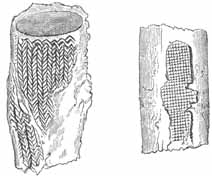|
undoubtedly has considerable effect on the preservation of bones after
burial. In graves apparently contemporary remarkable differences were
found. The depth of soil, too, has an influence. In some deep graves at
Sarr, scarcely a bone was preserved; in others, only a foot and a half or
two feet in depth, the skeletons were often entire; the soil being the
same in both instances. There was nothing remarkable in the size of the
bones. The largest femur exhumed measured 20½ inches, and as the hilts
or handles of the swords were rarely more than five inches in length, it
seems improbable that the men here buried exceeded ourselves in stature.
of the human jaw at Quignon, said to
have been exhumed from the Tertiary of the valley of the Somme, and to
have been contemporaneous with the flint implements of the drift, has been
supposed by some osteologists to have justified the suspicion that it
might have been taken from a graveyard in which the deposits scarcely
exceeded a century.
|
|
[To the end of Mr. Brent’s graphic account of his discoveries I append
engravings of two specimens of Saxon cloth preserved by the rust of iron
weapons, close to which they have lain in the graves, and to which they
still adhere. For more, see Pl. XI. All ornaments, weapons, etc.,
being found on the bodies in the positions in which they would naturally
be worn, it seems reasonable to suppose that a Pagan Saxon was buried in
his ordinary dress, and not in any special grave-clothes.—T. G. F]

|